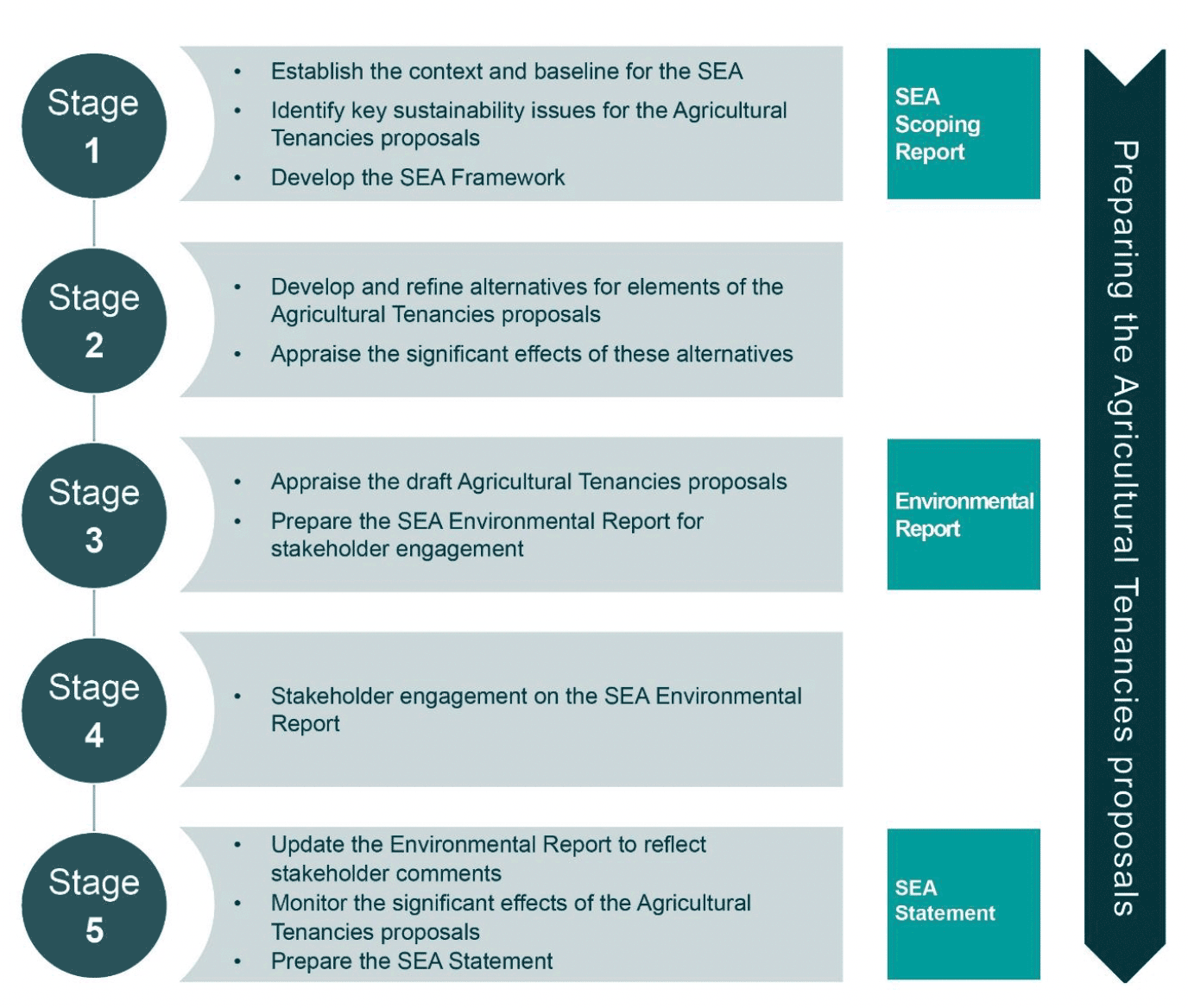Strategic Environmental Assessment (SEA) for the Agricultural Tenancies proposals Environmental Report
SEA is a systematic process for evaluating the environmental consequences of proposed plans, strategies, or programmes. This Report accompanies the Agricultural Tenancies proposals, within the Land Reform Bill.
2. Strategic Environmental Assessment (SEA) explained
Purpose of SEA
2.1 SEA considers and communicates the likely significant effects of an emerging plan, programme or strategy, and the reasonable alternatives considered during the plan making process, in terms of key environmental issues. The aim of SEA is to inform and influence the plan-making process with a view to avoiding or mitigating negative effects and maximising positive effects.
2.2 An SEA is undertaken in line with the procedures prescribed by the Environmental Assessment (Scotland) Act 2005.
2.3 The Act requires that an environmental report is published for consultation alongside the draft plan that ‘shall identify, describe and evaluate the likely significant effects on the environment of implementing (a) the plan or programme; and (b) reasonable alternatives to the plan or programme…taking into account the objectives and the geographical scope of the plan or programme.’ The report must then be taken into account, alongside consultation responses, when finalising the plan or strategy.
2.4 The ‘likely significant effects on the environment’, are those defined in the Act as ‘including on issues such as biodiversity, population, human health, fauna, flora, soil, water, air, climatic factors, material assets, cultural heritage including architectural and archaeological heritage, landscape and the interrelationship between the above factors’. Reasonable alternatives to the plan need to take into consideration the objectives of the plan and its geographic scope. The choice of 'reasonable alternatives' is determined by means of a case-by-case assessment.
Screening of the Agricultural Tenancies for SEA
2.5 SEA screening on the New Agricultural Bill was undertaken in late 2022, with an SEA Screening Report released to the environmental bodies in August 2022.[5]
2.6 This established that secondary legislation relating to the New Agriculture Bill (including the Agricultural Tenancies proposals) was likely to require SEA. In this respect it was viewed that the ‘Modernisation of Agricultural Tenancies’ components of the Bill fall under 5(4) of the Environmental Assessment (Scotland) Act 2005, and there is a likelihood of significant environmental effects.
Stages of SEA
2.7 The key stages of the SEA for the Agricultural Tenancies proposals are set out below.

Graphic text below:
Preparing the Agricultural Tenancies proposals
Stage 1 – SEA Scoping Report:
- Establish the context and baseline for the SEA
- Identify key sustainability issues for the Agricultural Tenancies proposals
- Develop the SEA framework
Stage 2:
- Develop and refine alternatives for elements of the Agricultural Tenancies proposals
- Appraise the significant effects of these alternatives
Stage 3 – Environmental Report:
- Appraise the draft Agricultural Tenancies proposals
- Prepare the SEA Environmental Report for stakeholder engagement
Stage 4:
- Stakeholder engagement on the SEA Environmental Report
Stage 5 – SEA Statement:
- Update the Environmental Report to reflect stakeholder comments
- Monitor the significant effects of the Agricultural Tenancies proposals
- Prepare the SEA Statement
This Environmental Report
Purpose of this Environmental Report
2.8 This Environmental Report accompanies the latest version of the Agricultural Tenancies proposals and is the main output of the SEA process. Its purpose is to:
- Identify, describe, and evaluate the likely significant environmental effects of the proposals and alternative approaches; and
- Provide a perspective on the likely environmental performance of the proposals and key areas for monitoring during its implementation.
2.9 The Environmental Report is the third document to be produced as part of the SEA process for the Agricultural Tenancies proposals. The first document was the Screening Report prepared in August 2022[6], and the second was the Scoping Report prepared in July 2023[7], which included information about the baseline and the ‘framework’ against which the proposals have been assessed.
Structure of this Environmental Report
2.10 In line with the provisions of the Environmental Assessment (Scotland) Act 2005, this Environmental Report has been structured as follows:
- Chapter 3 presents an overview of the scoping process for the SEA (Stage 1 in Figure 2.1).
- Chapter 4 presents an assessment of a number of alternative approaches relating to the broad principles underpinning the Agricultural Tenancies proposals. These have been assessed as reasonable alternatives (Stage 2).
- Chapter 5 presents an assessment of the current proposals, in terms of their likely significant environmental effects (Stage 3).
- Chapter 6 presents proposals for monitoring the significant environmental effects of the proposals, and opportunities for enhancements (linked to Stage 5).
- Chapter 7 subsequently sets out the next steps for the Agricultural Tenancies proposals and accompanying SEA process.
2.11 Consultation on this Environmental Report alongside the Agricultural Tenancies proposals comprises Stage 4.
Contact
There is a problem
Thanks for your feedback